
Computer generated evidence like forensic animation is becoming increasingly popular as a tool used in courtrooms around the country. Legal teams from all over are tapping into animation services to supplement their verbal argument with a powerful exhibit that makes it easy to show the court exactly what happened during an incident.
There are numerous studies that explain that the average attention span of a person can land anywhere between 8 and 12 seconds, which can make it difficult for lawyers whose primary goal is to present a narrative that is supported by facts and evidence. A group of jurors listening to an oral presentation for hours on end will tune out, get a glazed look in their eyes and miss vital information that is important to understand and remember when trying to reach a verdict.
The best way to explain a case to a jury, in a way that will help them understand the facts, comprehend difficult concepts and retain the information is through a well thought out, accurate, clean and visually appealing forensic animation. A courtroom animation may not be a perfect fit for every single case, but there are specific scenarios when it would be very beneficial.
This includes:
- Creating alternative scenarios, such as “right way, wrong way” situations
- Showcasing a specific sequence of events
- Visually depicting a crime
- Simplifying a complex scientific process
- Recreating the scene of an automobile collision or pedestrian accident
- Highlighting the moving parts of a piece of equipment or machinery
- Exploring a situation from different angles
- Highlighting anatomy or medical procedures
Utilizing animation can also allow a legal team to speed up or slow down time, which allows the jury to observe and pay attention to details that might not be clear to the naked eye.
These Types of Exhibits Need Forensic Animation
While trial graphics might not be the best option for all cases, there are three exhibits that you can’t have without forensic animation.
Sight Unseen
Perspective plays a huge role in many cases. It does not matter whether you are a plaintiff or defense attorney, it’s safe to assume that you have had to argue your client’s ability to see or not see an avoidable or unavoidable situation.
When you give the judge and jury the ability to “be in the driver’s seat” you are utilizing one of the most useful and powerful applications of 3D forensic animation.
In this animation we literally put the jury in the driver’s seat to show how this unfortunate situation was completely unavoidable.
We created animations from multiple perspectives to realistically and accurately depict a collision on a blind curve in the canyons of Los Angeles.
We worked with accident reconstruction experts, laser scan data, vehicle dynamics data and location based nighttime photography to put together these realistic and accurate depictions of the collision.
This forensic animation proved extremely useful in securing a high-dollar settlement for our client.
The Time Machine Demonstrative
It is not uncommon for investigations of cases to happen weeks, months, or even years after the fact. During this time the environment can change in a multitude of ways.
Trees that may have previously blocked the field of view could have been removed, a crosswalk has since been installed, or time has run its course and degradation of a previously safe area has now become unsafe.
3D computer animation can recreate these scenes to make sure your jury has an accurate depiction of the area at the time the incident took place.
The roadway in this animation had changed considerably between the time of the collision and the site inspection.
We used forensic animation to capture the scene exactly as it was at the time of the crash, the quintessential “Time Machine.” Our client tasked us with recreating a nighttime vehicular accident in which the plaintiff claimed that foliage on the median contributed to him being struck by a car. We had four animations entered as evidence and after the jury reviewed the animation, they decided that the city was not at fault.
Could Have, Should Have, Would Have…
What would have happened to your client if that department store had installed the handrail to code?
What would have happened had the plaintiff been traveling at the speed limit instead of 15 MPH faster?
3D animation has the power to ask and answer any of these questions, because we can manipulate the events of a situation by showing what could have happened, what should have happened and what did happen. A great example of this in action is the “avoidance scenario.”
In the case we are sharing here – the plaintiffs sued when their client was killed in a motorcycle collision with a box truck. The truck was performing a complex turn back into a parking lot, and the plaintiff tried to weave his way around the side of the truck with increased speed.
Our team was tasked with analyzing two surveillance cameras that caught different portions of the series of events, depicting the motorcycle at accurate speed and showing the box truck’s complicated maneuver accurately.
Additionally, in this animation we show exactly what would have happened had the plaintiff applied proper braking pressure along a proper path as opposed to trying to swerve around the truck.
Learn About Getting a Forensic Animation For Your Case
Forensic animation has the unique ability to bring clarity and understanding of an event unlike any other type of evidence, except for maybe eyewitness video.
With this service you can take your jury to the scene of the event as it unfolds, effectively transforming them into eyewitnesses. It also offers the added benefit of not only being a compelling visual experience for the jury, but it is one that can be shown multiple times throughout the trial, which will further strengthen your argument of the case.
If you’re curious about using forensic animation on a case or have questions about our work and services, please don’t hesitate to contact us to discuss your case.

Topics: